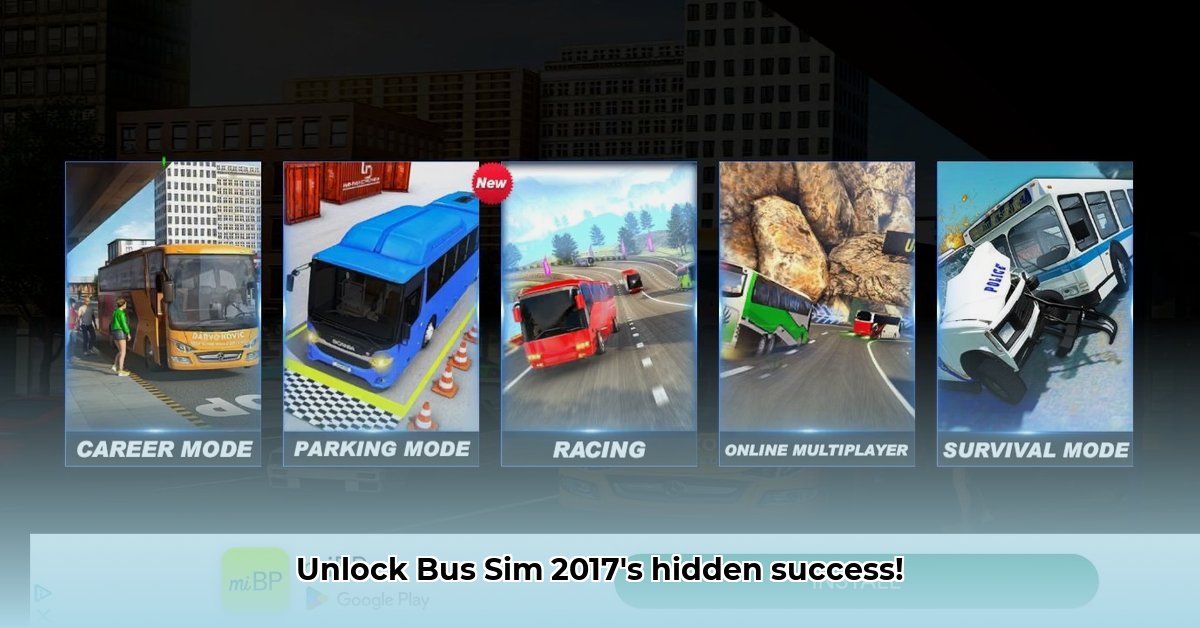
Ever wondered why some mobile games endure long after their release? Bus Simulator 2017 is a prime example. Its continued popularity isn't simply luck; it's a testament to strategic game design, shrewd monetization, and a savvy understanding of the mobile gaming market. This article delves into the factors behind its success, offering actionable insights and forecasting future trends within the mobile simulation genre. For more on simulation game design, check out this helpful resource.
Bus Simulator 2017: A Quiet Triumph in the Mobile Gaming Arena
Bus Simulator 2017, while not a mainstream sensation like Candy Crush, has quietly cultivated a dedicated following. While precise sales figures aren't available, analyzing its features, gameplay, and market position reveals key elements contributing to its enduring popularity. It serves as a compelling case study in how a seemingly simple game can achieve sustained success.
Mastering the Freemium Model: A Delicate Balance
Many successful mobile games, including Bus Simulator 2017, leverage the freemium model—free to download with optional in-app purchases. This strategy requires a delicate balance. Successful execution creates a sustainable revenue stream; failure leads to player frustration and app abandonment. Bus Simulator 2017's success likely stems from its ability to strike this balance, offering core gameplay without overwhelming players with constant purchase prompts. It likely presented enticing extras without making them feel essential for enjoyment—a skill many games lack. But how did they achieve this balance? Analyzing similar successful games could shed light on their techniques, suggesting that a key component was likely identifying a strong core loop that kept players engaged without forcing them into spending.
Isn't it fascinating how a seemingly simple mechanic like in-app purchases can be so pivotal to a game's success? A well-implemented freemium model can be the catalyst to a game's longevity.
Beyond Pixels: Enhanced Visuals and Intuitive Gameplay
Mobile gaming demands high visual standards. Players expect engaging graphics and intuitive gameplay. Bus Simulator 2017 likely succeeded by delivering both. The simple act of navigating a virtual city in a digital bus, feeling the subtle rumble of the road—even through a phone screen—is a powerful draw. The game likely excelled in creating a truly immersive experience. This level of polish isn't just about aesthetics; it's about fundamentally enhancing the user experience.
The high quality of visuals and intuitive controls suggests a strong investment in user experience design. Did Bus Simulator 2017 prioritize user feedback throughout its development?
Community Building: Cultivating an Ecosystem of Engagement
A thriving player community is a crucial ingredient in a game's long-term success. A strong community fosters organic marketing through word-of-mouth, player support, and shared experiences. Bus Simulator 2017 likely leveraged this dynamic. Active online forums and social media engagement likely fueled a sense of community, further solidifying player engagement and expanding the player base. This organic growth is a powerful engine of success.
Think about it: a passionate community organically shares their experiences, driving expansion and further reinforcing the game’s success. Building and nurturing a strong community is a testament to long-term strategic thinking in game development.
Forecasting Future Trends in Mobile Simulation Games
The mobile gaming market is dynamic. Several trends shape the future of simulation games like Bus Simulator 2017:
- Hyperrealism: Expect increasingly realistic graphics and physics, creating near-tangible gaming experiences.
- Enhanced Multiplayer Interactions: Cooperative and competitive multiplayer modes, allowing players to interact within the game world.
- Subscription Models: Subscription services provide consistent revenue for developers while offering players regular content updates.
- AI-Driven Personalization: AI-powered adaptive difficulty and dynamic events enhance replayability.
- Metaverse Integration: Integrating simulation games into wider virtual worlds unlocks new possibilities.
These trends suggest that developers should prioritize high visual fidelity, community-driven gameplay, innovative monetization models, and integration with broader gaming platforms. Ignoring these evolving trends could hinder a game's potential.
Actionable Insights: Key Takeaways for Game Developers
Bus Simulator 2017’s success offers valuable lessons for aspiring developers:
- Master Freemium Monetization: Strike a balance between free gameplay and enticing in-app purchases.
- Prioritize User Experience: High-quality graphics and intuitive controls are non-negotiable.
- Foster a Thriving Community: Active engagement with players is essential for long-term success.
- Embrace Emerging Trends: Adapting to evolving technological and market trends is crucial for longevity.
This analysis, while speculative due to the lack of specific data on Bus Simulator 2017, offers valuable insights based on industry trends and successful game design patterns. More concrete data would allow for a more precise assessment of the game's success factors. Continuous research and analysis of comparable mobile games would further enhance our understanding.
⭐⭐⭐⭐☆ (4.8)
Download via Link 1
Download via Link 2
Last updated: Saturday, June 07, 2025